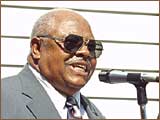UNDERGROUND RAILROAD MUSEUM DEDICATED IN LAWNSIDE
Historic Peter Mott House Officially Opens to Public

By Hoag Levins ...| ...October 14, 2001

LAWNSIDE, N.J. -- On an afternoon so brilliant with sunlight that some of the arriving guests suggested God Himself was smiling down, the Peter Mott House was officially dedicated yesterday as an Underground Railroad historic site and museum.
The ceremony, which officially opened the house as a public museum, capped an effort that began in 1989 to save the collapsing wooden structure from demolition and restore it as a memorial to this community's historic involvement in the nineteenth-century fight against slavery.
In 1994 the site was officially recognized and added to both the State and National Registers of Historic Places.
Monument to freedom
Linda Waller, President of the Lawnside Historical Society specifically created in 1990 to save the Mott House, hailed it as "a monument to freedom."
"The Underground Railroad was a system committed to the human desire for freedom," she told a standing-room-only crowd in the small amphitheater area behind the historic building. "Every man and every woman wants to be free, and that's what we celebrate here today."
"This is a very happy day," she continued. "So many people have
come forward with artifacts and stories to share and bits of information from their families that have really helped turn the idea of creating a museum in Lawnside into a reality."
Helped slaves escape
Constructed 156 years ago, the two-story clapboard house was the home of a free black farmer and businessman who, in the pre-Civil War era, helped runaway slaves make their way north toward freedom through southern New Jersey.
Despite the presence of numerous state and local government officials, the real celebrity of the day was Clarence Still, the local historian and descendant of eighteenth-century abolitionist William Still, who prevented the demolition of the property in 1989 and set in motion the efforts that became today's grand opening.
Recovering from an illness that has made his walk unsteady

|
| Photo: Hoag Levins. |
|
Clarence Still, the Lawnside historian who started the movement that saved the Peter Mott House.
Listen to Still (RealAudio)
|
|
and requires him to use a wheelchair, Still's mere arrival at the site caused a stir in the crowd.
'Eagle eye'
State Senator Wayne R. Bryant, who helped the Lawnside historian walk to the microphone, called Still the "eagle eye."
"This is the man without whom the building behind us would have been buried in the ground and forgotten," said Sen. Bryant. "He had the vision, and that vision has become fact because of a decade of support and work by so many other people."
"When I woke up this morning," said Still, the founding President of the Lawnside Historical Society, "I said, 'This is a blessed day -- because I'm still here and also because this is our opening day.'"
Then, instead of dwelling on the work completed, he asked the crowd to look toward the work that needs to be done to make the museum a dynamic historic site. "Our work is really just beginning," he said. "We're going to need more people to come out and volunteer their services with us."

|
| Photo: Hoag Levins. |
|
Lawnside Mayor Mark K. Bryant: 'A demonstration of how committed people can come together to make something wonderful happen.'
Listen to Bryant (RealAudio)
|
|
Tourism potential
Lawnside Mayor Mark K. Bryant noted, "Our community is so enriched by the presence of the Peter Mott House. It adds an element of tourism to Lawnside that we've not had before, and we're looking to build on that."
John Seitter, Executive Director of the Camden County Historical Society (CCHS), characterized the new museum as "a magnificent achievement." CCHS operates an extensive museum and research library in Camden. It also operates and interprets Pomona Hall, a restored eighteenth-century mansion that was once the centerpiece of a local plantation that held slaves. CCHS is among those who have loaned artifacts for use in the Mott House.
'Important new resource'
Seitter, who has been lobbying for better coordination among the county's historical and cultural institutions, said the Peter Mott House was "an important new resource for all organizations seeking to interpret and celebrate the rich multicultural history of this region."
| 


